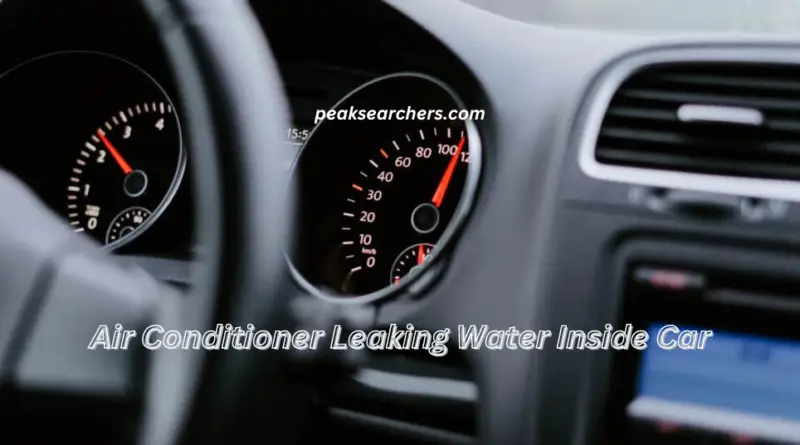How to Fix Air Conditioner Leaking Water Inside Car? A Comprehensive Guide
If you own a car with an air conditioner, it is essential to ensure that it is working optimally. However, you may encounter some issues with your car’s air conditioner, one of which is leaking water inside the car.
This problem can be both frustrating and uncomfortable, especially during hot weather. As it was with me. Once I was going into a meeting and my shoes got wet due to the leakage of water inside the car. I was infuriated and my meeting was a mess.
Luckily, you can fix this problem easily and quickly without seeking professional help. In this article, we will provide you with comprehensive and detailed steps on how to fix your car’s air conditioner leaking water inside the car. Follow these steps carefully, and you will have your car air conditioner running optimally again.

Diagnosing the Problem
Before fixing the issue, it is important to understand what is causing the water leaks in the first place. Typically, the cause of the problem is a clogged drain line. As your air conditioner cools the air inside your car, it also removes humidity. This results in water condensation that collects in the evaporator unit. The water is then drained through a line that runs to the bottom of your car.
However, over time, dirt, debris, and mold can accumulate in the drain line, blocking the water flow and causing it to back up into the car’s interior. To confirm that this is the issue, you can inspect the area beneath the dashboard on the passenger side for water accumulation.
Fixing the Problem
Here are the steps to follow to fix the air conditioner leaking water inside your car:
Step 1: Locate the drain line
The drain line is usually located on the passenger side of the vehicle, near the front floorboard. Look for a rubber hose that runs from the evaporator unit and through the floorboard.
Step 2: Clear the drain line
Use a wet-dry vacuum or compressed air to blow out any debris, mold, or dirt that is blocking the drain line. You can also use a wire coat hanger to gently push through any clogs.
Step 3: Test the drain line
Once you have cleared the drain line, test it to ensure that the water is draining properly. You can pour a small amount of water into the evaporator unit’s drain pan and observe if it flows freely out of the hose.
Step 4: Check the Refrigerant Level
The refrigerant is responsible for cooling the air that flows through your car’s air conditioning system. If the refrigerant level is low, it can cause the evaporator to work inefficiently and even freeze up. When this happens, the ice can melt and leak inside the car.
To check the refrigerant level, you will need to take your car to a professional mechanic who has the necessary equipment and expertise. The mechanic will inspect your car’s air conditioning system and check the refrigerant level. If the level is low, they will add the necessary amount of refrigerant to restore the system’s optimal performance.
Step 5: Clean the Evaporator Unit
While you’re at it, it’s a good idea to clean the evaporator unit to prevent future blockages. Use a mild detergent and warm water to clean the unit thoroughly.
Step 6: Replace the Cabin Air Filter
Finally, replace your cabin air filter, which helps to prevent debris and mold from accumulating in the drain line. This should be done at least once a year.
Also Read: How Many Solar Panels To Run Air Conditioner? A Comprehensive Guide
FAQ’s
Why does my car leak water when the AC is off?
A car may leak water when the AC is off due to condensation or damaged weatherstripping. Condensation can form on the evaporator coil even when the AC is not in use, causing water to collect and leak into the car if the drain line is clogged or damaged.
Damaged weatherstripping can also allow rainwater to enter the car. It’s best to have a professional mechanic inspect the issue to prevent further damage.
Can I drive my car with a clogged drain line?
It is not recommended to drive your car with a clogged drain line as it can cause water to back up and leak into the interior of the car.
The accumulated water can cause damage to the carpet, upholstery, and electronic components. Moreover, it can create a musty odor and promote the growth of mold and mildew, which can pose a health hazard.
It’s best to have the clogged drain line addressed by a professional mechanic as soon as possible to avoid any potential damage.
Is it safe to clean mold and mildew in a car by myself?
Cleaning mold and mildew in a car by yourself can be safe if you take the proper precautions and use the appropriate cleaning materials. However, it’s important to note that mold and mildew can be harmful to your health if you inhale the spores or come into direct contact with them.
To clean mold and mildew in your car, wear protective gloves, a mask, and safety goggles. Use a cleaning solution specifically designed to kill mold and mildew, and avoid using bleach or other harsh chemicals that can damage the upholstery or electronics in your car.
It’s also important to address the source of the mold and mildew, such as a leaky air conditioner, and ensure that it has been fixed before cleaning. If the mold and mildew growth is extensive or you’re not comfortable cleaning it yourself, it’s best to have a professional detailer or mold remediation specialist handle the cleaning.
What is the most common leak in a car AC system?
The most common leak in a car AC system is from the compressor shaft seal. The compressor is a vital component of the AC system, and its shaft seal keeps the refrigerant from leaking out.
Over time, the seal can wear out or become damaged, causing the refrigerant to leak from the compressor. This can cause the AC system to lose its cooling power, and the compressor may eventually fail if the refrigerant level drops too low.
If you suspect a leak in your car’s AC system, it’s best to have it inspected by a professional mechanic to determine the cause and prevent further damage.
Also Read: How to Clean a Portable Air Conditioner: A Comprehensive Guide
Conclusion
In summary, fixing the air conditioner leaking water inside your car is a simple process that you can do on your own. By following the steps outlined above, you can save money on repair costs and prevent future water leaks. Remember to keep your car’s air conditioning system well-maintained to avoid further problems


